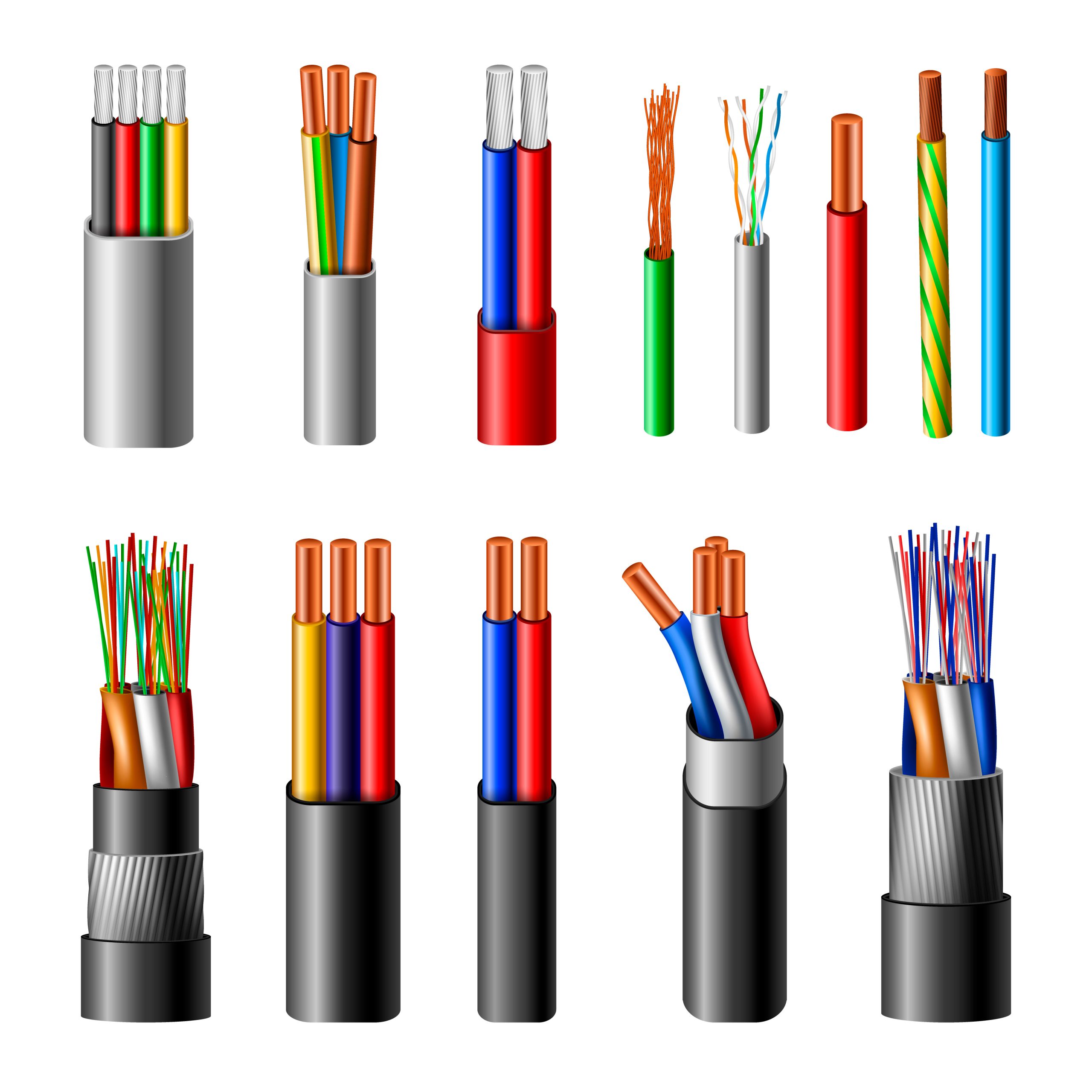3 Different Types of Cables and its Uses

Electrical cables are an essential part of our modern world. They are used to transmit electrical power and signals, and to connect devices.
Electrical cables are made up of one or more conductors that are insulated to prevent electrical shocks and short circuits. The conductors are typically made of copper or aluminum, and the insulation is made of plastic or rubber.
Electrical cables come in a variety of sizes, shapes, and materials to suit different applications. For example, household electrical wires are typically small and flexible, while industrial power cables are large and rigid.
The type of electrical cable that is used depends on the application. For example, a power cable that is used to transmit electricity over long distances will be different from a cable that is used to connect a computer to a printer.
Electrical cables are an important part of our infrastructure, and they play a vital role in our everyday lives. They allow us to power our homes and businesses, and to communicate with each other.
Here are some additional details about electrical cables:
- The conductors in an electrical cable are typically made of copper or aluminum because these metals are good conductors of electricity.
- The insulation on an electrical cable is typically made of plastic or rubber because these materials are good insulators of electricity.
- The size of an electrical cable is determined by the amount of current that it needs to carry.
- The shape of an electrical cable is determined by the application that it is being used for.
- The material of an electrical cable is determined by the environment in which it will be used.
Types of Cables
Broadly, Cables are divided in three categories for better understanding based on their functionality. Cables can be divided into Power Cables, Computer Cables and Electrical Cables.
What are Power Cables?
Power cables are cables used to transmit electrical power. There are different types of power cables, including:
- Single-core cables: consist of one conductor surrounded by an insulating layer and a protective sheath.
- Multi-core cables: contain several conductors insulated from each other and surrounded by a common protective sheath.
- Armoured cables: have an additional layer of steel wire or tape for mechanical protection.
- Unarmoured cables: do not have any additional mechanical protection.
- High-voltage cables: designed for transmitting high levels of electrical power over long distances.
- Low-voltage cables: used for lower levels of power transmission, typically within buildings or short distances.
What are Computer Cables?
Computer cables are used to connect different devices to each other. Some common types of computer cables include:
- HDMI cables for digital video and audio signals
- USB cables for connecting devices such as printers, cameras, and external hard drives
- Ethernet cables for network connections
- VGA cables for analog video signals
- DisplayPort cables for digital video signals
What are Electrical Cables?
Electrical cables are used to transmit power and data in various applications. They are a set of wires that are bundled together and used to transmit electrical energy or signals. There are several types of electrical cables, each designed to meet specific requirements. The four main types of electrical cables are
- Coaxial cables
- Flexible Cables
- Twisted pair cables
- Shielded cables - with PVC & Copper
- Ribbon cables
Each type of cable has unique features and is designed for specific applications. It is important to choose the appropriate cable for your electrical needs to ensure safety and efficiency.
Construction of an Electrical Cable:
An electrical cable typically consists of one or more conductors (wires) made of copper or aluminum, surrounded by insulation material, and covered by a protective jacket. The conductors carry electrical current, while the insulation prevents the current from escaping and the protective jacket provides physical protection. The specific construction of the cable can vary depending on its intended use and the environment it will be installed in.
Differences between Wires and Cables
A wire is a single strand or conductor that may be made of copper, aluminum, or other materials. It is used to transmit electrical signals or power from one point to another. A cable, on the other hand, is made up of multiple wires or conductors that are twisted or bound together. This twisting or bundling helps to reduce interference and noise in the signal.
Electric Wires and Cables differ from one another in many other ways. Cables can also be shielded to provide additional protection from interference. Additionally, cables may have insulation or a jacket surrounding the conductors to protect them from damage or environmental factors.
To sum it up, the main differences between a wire and a cable are that a wire is a single conductor, while a cable is made up of multiple conductors twisted or bound together. Wires are typically single conductors made of a conductive material like copper or aluminum.
Cables, on the other hand, are made up of two or more wires that are twisted, braided, or bonded together. Cables are often insulated and can have protective coverings or sheaths. Wires are usually used for simple applications, while cables are used for more complex applications. Cables can transmit power and data over long distances, while wires are better suited for shorter distances.
Electric wires are commonly used to transmit electrical power and signals from one location to another. They are also used in the construction of electrical circuits and in the installation of electrical appliances and lighting systems. Additionally, electric wires are often used in the production of electronic devices, such as computers and mobile phones.
Tips To Choose The Right Electric Wire And Electric Cable For Your Home And Industries
- Determine the required voltage and current capacity for your application.
- Choose the appropriate wire gauge based on the expected load and distance between power source and device.
- Consider the insulation material and temperature rating required for the application.
- Choose a cable with appropriate shielding to prevent interference and signal loss.
- For industrial applications, consider factors such as abrasion resistance and chemical compatibility.
- Ensure compliance with relevant safety standards and regulations.
- Consult with a qualified electrician or engineer if unsure.
Applications of Cables:
Earlier in the article, we did list down the various types and categories of cables. Just as their usage differs in a vast way, their applications in the everyday framework of tasks are different and unique. Every type of cable inhibits and works for a certain set of tasks. Listed below are the applications and uses of some of the popular cables that we use in the day-to-day.
- Coaxial cables - These are used for transmission of radio frequency signals. They have a central conductor surrounded by a dielectric insulator and an outer conductor. Coaxial cables are used in television, internet, and telecommunication systems.
- Optical fibers - These cables are used to transmit light signals for communication and data transfer. They are made of glass or plastic fibers and are used in high-speed internet, telecommunication, and medical equipment.
- Shielded cables - These cables have a metallic shield around them to protect against electromagnetic interference. They are used in industrial applications, aerospace, and military equipment.
- Unshielded cables - These cables do not have a metallic shield and are used in low-voltage applications such as home wiring and computer networks.
- Twisted pair cables - These cables have two or more insulated wires twisted together to reduce electromagnetic interference. They are used in telephone lines, Ethernet networks, and audio equipment.
- Armoured cables - These cables have an additional layer of protection in the form of metal wire or tape. They are used in underground or outdoor installations to protect against mechanical damage.
- Heating cables - These cables are used for heating applications, such as floor heating or snow melting. They are made of a resistive material that produces heat when an electric current passes through them.
- High voltage cables - These cables are designed to transmit high voltage power over long distances. They are used in power grids and other high voltage applications.
Applications of Electric Cables:
If we were to singularly understand the applications and uses of the electrical cables alone, we would be staring at a rather long list of its uses. Electric cables are used in a variety of applications, including:
- Power transmission and distribution
- Communication systems
- Electrical wiring in buildings and homes
- Industrial machinery and equipment
- Automotive and transportation systems
- Medical equipment and devices
- Aerospace and defense systems
- Renewable energy systems such as wind turbines and solar panels
In conclusion, electrical cables come in different types and are used in various functional uses. The choice of the best electric cable depends on the specific requirements of the application, such as voltage, frequency, and environmental conditions. It is important to choose the right type of cable to ensure safe and reliable operation of the system.
FAQ's:
What is an electrical cable?
What are the different types of electrical cables?
i) Power cables: These cables are used to transmit electrical power over long distances. They are typically made of copper or aluminum conductors and are insulated with a thick layer of plastic.
ii) Control cables: These cables are used to transmit electrical signals between devices. They are typically made of stranded copper conductors and are insulated with a thin layer of plastic.
iii) Signal cables: These cables are used to transmit audio, video, and data signals. They are typically made of stranded copper conductors and are insulated with a thin layer of plastic.
iv) Fire-resistant cables: These cables are designed to resist the spread of fire. They are typically made of a special type of insulation that is resistant to heat and flames.
How do you choose the right electrical cable for your needs?
i. The amount of current that the cable will need to carry
ii. The type of insulation that is required
iii. The environment in which the cable will be used
iv. The cost of the cable
How do you install electrical cable?
1. Plan the route of the cable.
2. Cut the cable to length.
3. Strip the insulation from the ends of the cable.
4. Connect the cable to the electrical devices.
5. Secure the cable in place.
How do you terminate electrical cable?
What are the safety precautions for working with electrical cable?
i. Always turn off the power to the circuit before working on the cable.
ii. Use the right tools for the job.
iii. Be careful not to cut yourself on the cable.
iv. Do not touch the exposed conductors.
How do you troubleshoot electrical cable problems?
1. Check the fuse or circuit breaker to make sure that it is not tripped.
2. Check the connections to make sure that they are tight.
3. Replace the cable if it is damaged.




